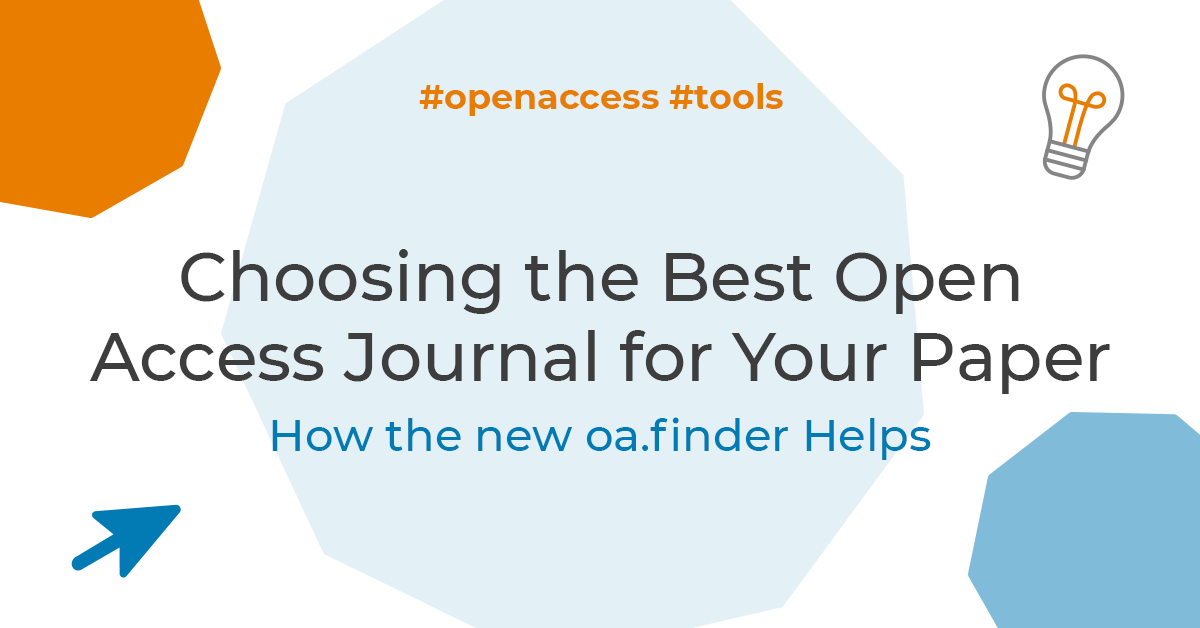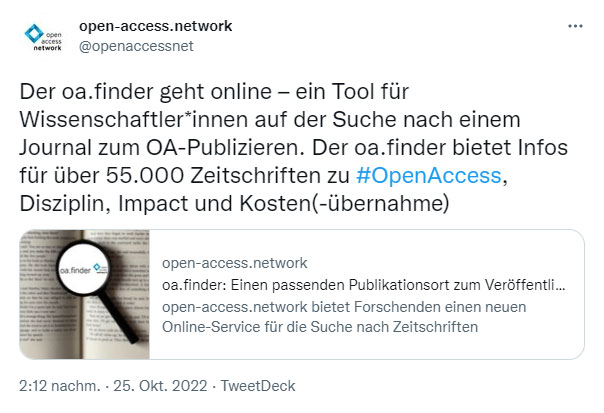Which journal is the right one for the paper I am planning? Faced with thousands of specialist journals, choosing the right one is a challenge. Especially if you want to publish in Open Access and have to keep an eye on the financing of possible fees. The new tool oa.finder now offers further support with its extensive search and filter options.
At the end of October 2022, the new KB entry was launched. Developed as part of the joint project "open-access.network" funded by the Federal Ministry of Education and Research and operated by Bielefeld University Library, the free search tool provides information on Open Access, subject and impact for over 55,000 journals. The oa.finder thus helps researchers to identify a suitable journal for publishing in Open Access.
How to select a suitable publication location with the oa.finder:
- Select in the field "My publication type" which type of publication you are planning. Currently, this only works for journal articles. However, a search option for publishers that publish monographs, edited volumes and conference proceedings in Open Access is in preparation. Click on "My role" to indicate your role in the publication process. Enter your research institution under "My organization". As soon as you start entering its name, suitable institutions will be suggested to you for selection.
- You will then be presented with a comprehensive list of possible journals. If you apply the available filter, sort and search options, this list becomes clearer for your journal selection: For example, you can filter by subject, such as "economics". Other filter options include publisher, publication language, or specific Open Access forms. You can also sort the information using rankings such as the VHB-JOURQUAL3 or the VWL ranking. You can then start more targeted searches in the displayed results, for example based on keywords or journal titles. Furthermore, you can narrow down the results based on the level of Open Access Publication Charges (APCs).
- In the list of results, you will find information about the amount of Open Access Publication Charges (APCs) as well as the respective funding options, for instance via transformation contracts or publication funds of your institution.
- The individual journal hits can be displayed in full length. You will then get more detailed information about the respective journal, organised under the four tabs "Journal Overview", "Journal Details", "APCs" and "Journal Metrics". Here you will find, among other things, information about its Open Access policy, licences used, persistent identifiers used, the review process, the estimated duration of the publication process, and the placement in the various rankings.
Get support at your own institution
If you select the other tabs at the top next to the "Journals" tab of the results list, you will see background information about your institution. Under "Open Access at your institution" and "Transformation contracts at your institution" you will find, among other things, your institution's Open Access policy, publication funds, and publication services, as well as an overview of the Open Access transformation contracts in which your institution is involved.
Even though all the information contained in oa.finder is regularly checked and updated, it is advisable to double-check for yourself before submitting, just to be on the safe side, that the journal details and funding options that are crucial to you are accurate. As far as the payment of publication fees is concerned, it is recommended that you check the Open Access website of your library or the research funding department at your institution and consult the contact persons there.
By the way: The team behind the oa.finder offers training appointments for researchers, and individual consultation appointments can also be arranged individually or in groups, by phone or online. Names and contact details of the contact persons can be found directly on the home page of the tool.
More information about the oa.finder and even more Open Science tools can be found in the tool directory. Even more tips for choosing a suitable journal and tools for choosing a suitable publication venue can also be found in the Open Economics Guide.
Another tip: Sign up to the free Open Economic Guide newsletter to stay up-to-date on everything Open Science!

